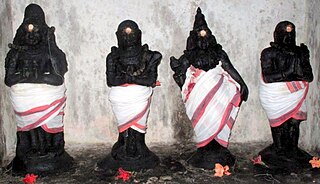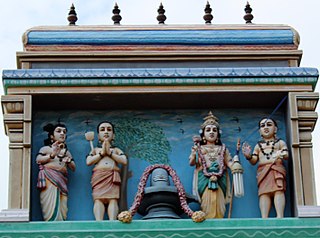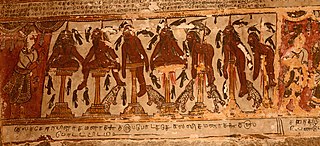Related Research Articles

The Tamil Sangams were assemblies of Tamil scholars and poets that, according to traditional Tamil accounts, occurred in the remote past. Scholars believe that these assemblies originally known as kooṭam or "gathering," which was also a name for Madurai. Three assemblies are described. The legend has it that the first two were held in cities since "taken by the sea", the first being called Kapatapuram, and the third was held in the present-day city of Madurai.

Sambandar, also referred to as Tirugnana Sambandar, Tirujnanasambanda, Campantar or Jñāṉacampantar, was a Shaiva poet-saint of Tamil Nadu who lived sometime in the 7th century CE. He was a child prodigy who lived just 16 years. According to the Tamil Shaiva tradition, he composed an oeuvre of 16,000 hymns in complex meters, of which 383 (384) hymns with 4,181 stanzas have survived. These narrate an intense loving devotion (bhakti) to the Hindu god Shiva. The surviving compositions of Sambandar are preserved in the first three volumes of the Tirumurai, and provide a part of the philosophical foundation of Shaiva Siddhanta.

Tirumurai is a twelve-volume compendium of songs or hymns in praise of Shiva in the Tamil language from the 6th to the 11th century CE by various poets in Tamil Nadu. Nambiyandar Nambi compiled the first seven volumes by Appar, Sambandar, and Sundarar as Tevaram during the 12th century. During the course of time, a strong necessity was felt by scholars to compile Shaiva literature to accommodate other works. Tiruvasakam and Tirukovayar by Manickavasagar are included as the eighth, nine parts are compiled as the ninth Tirumurai out of which most are unknown, and the tenth as Tirumandiram by Tirumular, the famous Siddhar. The eleventh is compiled by Karaikal Ammaiyar, Cheraman Perumal and others. The contemporary Chola king was impressed by the work of Nambi and included Nambi's work in the eleventh Tirumurai. Sekkilar's Periya Puranam, composed a century later, contains the life depiction of all the 63 Nayanmars. The response for the work was so tremendous among Shaiva scholars and Kulothunga Chola II that it was included as the 12th Tirumurai. Tirumurai along with Vedas and Shaiva agamas form the basis of Shaiva Siddantha philosophy in South India and Sri Lanka.

Thiruvasagam is a volume of Tamil hymns composed by the ninth century Shaivite bhakti poet Manikkavasagar. It contains 51 compositions and constitutes the eighth volume of the Tirumurai, the sacred anthology of the Tamil Shaiva Siddhanta.

Appar, also referred to as Tirunāvukkarasar or Navukkarasar, was a seventh-century Tamil Śaiva poet-saint. Born in a peasant Śaiva family, raised as an orphan by his sister, he lived about 80 years and is generally placed sometime between 570 and 650 CE. Appar composed 4,900 devotional hymns to the god Shiva, out of which 313 have survived and are now canonized as the 4th to 6th volumes of Tirumurai. One of the most prominent of the sixty-three revered Nayanars, he was an older contemporary of Thirugnana Sambandar.

Sundarar, also referred to as Chuntarar, Chuntaramurtti, Nampi Aruran or Tampiran Tolan, was an eighth-century poet-saint of Tamil Shaiva Siddhanta tradition of Hinduism. He is among the Tevaram trio, and one of the most prominent Nayanars, the Shaiva bhakti (devotional) poets of Tamil Nadu.

Manikkavacakar, or Maanikkavaasagar(Tamil: மாணிக்கவாசகர், "One whose words are like gems"), was a 9th-century Tamil saint and poet who wrote Tiruvasakam, a book of Shaiva hymns. Speculated to have been a minister to the Pandya king Varagunavarman II, he lived in Madurai.

Arulmigu Murugan Temple, Thiruparankundram is a Hindu temple dedicated to the god Murugan at Thiruparankundram, Tamilnadu, India. It is regarded as one of the "six Abodes of Murugan". The temple is built in rock-cut architecture and believed to have been built by the Pandyas during the 6th century. According to the legend. it is where Murugan slayed the demon Surapadman and married Devasena also known as Deivayanai, the daughter of the king of heavens, Indra. Also, Murugan is said to have worshipped his father Shiva here as Parangirinathar.

The Tevaram, also spelled Thevaram, denotes the first seven volumes of the twelve-volume collection Tirumurai, a Śaiva narrative of epic and Puranic heroes, as well as a hagiographic account of early Saiva saints set in devotional poetry. The Tevaram volumes contain the works of the three most prominent Saiva Tamil poets of the 7th and 8th centuries: Sambandar, Appar, and Sundarar. The three poets were not only involved in portraying their personal devotion to Shiva, but also engaged a community of believers through their songs. Their work is an important source for understanding the Śaiva Bhakti movement in the early medieval South India.
Jainism is a religion founded in ancient India. Jains trace their history through twenty-four tirthankara and revere Shree Rishabhnatha Bhagwan as the first tirthankara. The last two tirthankara, the 23rd tirthankara Parshvanatha and the 24th tirthankara Mahavira are considered historical figures. According to Jain texts, the 22nd Tirthankara Neminatha lived about 5,000 years ago and was the cousin of Sri Krishna Bhagwaan.
Arikesari Maravarman, also known as Parankusa, was a Pandya king of early medieval south India.

Edaganathar Temple is a Hindu temple dedicated to the deity Shiva, located in Thiruvedagam, a village in Madurai district in the South Indian state of Tamil Nadu. The temple is located on the banks of Vaigai River. Shiva is worshipped as Edaganathar, and is represented by the lingam. His consort Parvati is depicted as Visalakshi. The presiding deity is revered in the 7th century Tamil Saiva canonical work, the Tevaram, written by Tamil saint poets known as the nayanars and classified as Paadal Petra Sthalam.

Thiruvathigai Veerateswarar Temple is a Hindu temple dedicated to Shiva. It is situated in Thiruvathigai village which is about 2 kilometres east from the town of Panruti in the South Indian state of Tamil Nadu, India. Shiva is worshiped as Veerattaaneswarar, and is represented by the lingam. His consort Parvati is depicted as Thiripurasundari. The presiding deity is revered in the 7th-century Tamil Saiva canonical work, the Tevaram, written by Tamil saint poets known as the nayanars and classified as Paadal Petra Sthalam. The temple is considered the place where the Saiva saint poet Appar (Thirunavukkarasar) converted back to Saivism, and attained final salvation.

Jainism has an extensive history in the Indian state of Tamil Nadu, although practiced by a minority of Tamils in contemporary times. According to the 2011 India Census, Jains represent 0.12% of the total population of Tamil Nadu, and are of the Digambara sect. Tamil Jains are primarily concentrated in northern Tamil Nadu, in the districts of Madurai, Viluppuram, Kanchipuram, Vellore, Tiruvannamalai, Cuddalore and Thanjavur.

The impalement of the Jains is a 7th-century event, first mentioned in an 11th-century hagiographic Tamil language text of Nambiyandar Nambi. Sambandar defeated the Tamil Jain monks in a series of debates and contests on philosophy, thereby converted a Jain Pandyan king to Shaivism. The episode ended with the impalement of 8,000 Tamil Jains or Samanars as they were called. According to the early version of the legend, the Jains voluntarily impaled themselves in order to fulfill their vow after losing the debate. According to a much later version of the legend found in Takkayakapparani – a war poem, the newly converted king ordered the Jains to be impaled at Sambandar's instigation. The Pandyan king, variously called "Koon Pandiyan" or "Sundara Pandyan" in the legend is identified with the 7th century ruler Arikesari Maravarman.
Samanatham is the name of a panchayat village in the Madurai district of Tamil Nadu, India. It comes under the Thiruparankundram block."Sama Natham" a corrupt version of 'Samanar Rattham' or 'blood of Jains' is situated about six kilometers away from Madurai and a winding path among Acacia bushes and thorns leads one to a place worshipped as Mayandi temple. The place is isolated and is located in an eerie environment. But for the 10 foot trident and stone pillars with a hanging bell, there is nothing to suggest that it is a temple.
Mangayarkkarasiyar (Tamil:மங்கையர்க்கரசியார்) was one of the 63 Nayanmars or holy Saivite saints who are revered in South India. She is one among the only three women who attained this distinction. Her devotion to Lord Shiva is recounted in the hagiographic poem Periyapuranam compiled by Sekkizhar as well as in the Tiruthondar Thogai written by the poet-saint Sundarar.
Kulachirai Nayanar was a minister of the Pandyan king, Koon Pandyan, and one of the 63 Nayanars mentioned in the Periya Puranam.
Murthi Nayanar, also spelt as Murthy Nayanar, Moorthy Nayanar and Murti Nayanar and also known as Murtti, is a Nayanar saint, venerated in the Hindu sect of Shaivism. He is generally counted as the fifteenth in the list of 63 Nayanars.
Tiru Nilakanta Yazhpanar was a Nayanar saint, venerated in the Hindu sect of Shaivism. He is generally counted as the sixty-first in the list of 63 Nayanars. While the first part of his name can be spelt as Tirunilakanta, Tirunilakantha, Tiru Neelakanta, Tiru Nilakanta, Nilakantan and Thiruneelakanda, Yazhpanar is spelt as variously as Yalppanar, Yalapannar, Yalpanar and Yazhpaanar. He is described as a companion of Sambandar, one of the most prominent Nayanars.
References
- 1 2 "Staunch devotion". The Hindu . Chennai. 15 May 2009. Archived from the original on 27 February 2014. Retrieved 25 February 2013.
- ↑ "The Temple At Thirunallar". District Administration, Karaikal. Retrieved 25 February 2013.
- ↑ Paul Dundas (2002). The Jains. Routledge. p. 127. ISBN 978-0-415-26606-2 . Retrieved 25 February 2013.
- ↑ Marco Polo; Sir Henry Yule (1875). The Book of Sir Marco Polo, the Venetian, Concerning the Kingdoms and Marvels of the East: Newly Tr. and Ed., with Notes, Maps, and Other Illustrations. J. Murray. pp. 317–. ISBN 9780404115425 . Retrieved 16 August 2013.
- ↑ Somasundaram O, Tejus Murthy AG, Raghavan DV (2016), "Jainism - Its relevance to psychiatric practice; with special reference to the practice of Sallekhana", Indian J Psychiatry, 58 (4): 471–474, doi:10.4103/0019-5545.196702, PMC 5270277 , PMID 28197009
{{citation}}: CS1 maint: multiple names: authors list (link) - ↑ James Hastings (2003). Encyclopedia of Religion and Ethics Part 9. Kessinger Publishing. p. 23. ISBN 978-0-7661-3680-9 . Retrieved 25 February 2013.
- ↑ Purnalingam Pillai, M. S. (1994). Tamil Literature - M. S. Pillai - Google Books. ISBN 9788120609556 . Retrieved 14 February 2013.
- ↑ Ashim Kumar Roy (1984). "9. History of the Digambaras". A history of the Jainas. Gitanjali. Archived from the original on 23 February 2018. Retrieved 22 May 2013.
- ↑ K. A. Nilakanta Sastri (1976). A history of South India from prehistoric times to the fall of Vijayanagar. Oxford University Press. p. 424. ISBN 978-0-19-560686-7 . Retrieved 23 May 2013.
- ↑ James Henry Nelson (1989). The Madura Country: A Manual. Asian Educational Services. p. 2. ISBN 978-81-206-0424-7 . Retrieved 25 February 2013.